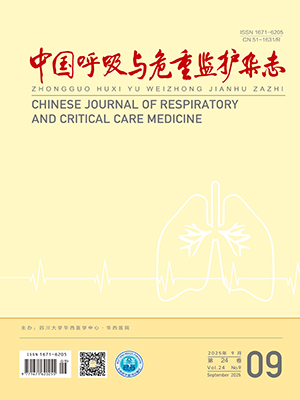Objective To investigate the safety and effectiveness of a self-made bronchoscopic catheter ( an improved artificial airway) in bronchoscopic interventional therapy.
Methods 126 patients planning to receive bronchoscope between October 2012 and February 2013 were divided into A, B and C groups. Three groups received inhalation of 2% lidocaine 5mL for surface anesthesia, and the venous channel was build up. Then the patients in group A ( n = 45) were treated with conventional bronchoscope. The patients in group B ( n =40) were treated with painless bronchoscope ( received intravenous injection with midazolam0. 06 mg/kg and fentanyl 1μg/kg before operation) . The patients in group C ( n = 41) were treated with painless bronchoscope through improved artificial airway ( after anesthesia similar to group B, the improved artificial airway was implanted through the mouth guided by bronchoscope, then the bronchoscopy was performed through artificial airway) . Blood pressure, respiration rate, heart rate and the pulse oxygen saturation were measured by multi-parameter ECG monitor before and during the operation, and the differences were compared among three groups. Body movement, transient respiratory depression during the operation, and postoperative feelings and reactions after operation were also observed. Meanwhile, the convenience of operation by physicians was evaluated.
Results The blood pressure fluctuations in group C and group A had no significant difference ( P gt;0. 05) . Heart rate of three groups was somewhat increased,but there was no significant difference between group C and group A ( P gt; 0. 05) . Body movement and postoperative pain memory in group B and group C were better than those in group A ( P lt; 0. 05) .Respiratory depression of three groups had no significant difference ( P gt; 0. 05) . The operative convenience and the comfort of physicians in group C were better than those in group A and group B ( P lt; 0. 05) .
Conclusions Operation safety of bronchoscopic interventional treatment with improved artificial airway is similar to the conventional procedure, but the reaction of the intra-operation and postoperative painful memories are significantly superior to conventional bronchoscopy. The convenience of operation and comfort of physicians are much better than the conventional bronchoscopy. It can be concluded that the improved artificial airways is worthy of clinical application.
Citation: HE Zhengguang,QIU Rong,ZHAO Jie,LUO Xiaobin. Application of Improved Artificial Airway in Interventional Therapy with Bronchoscope. Chinese Journal of Respiratory and Critical Care Medicine, 2013, 12(5): 494-498. doi: DOI: 10 . 7507 /1671 -6205 . 20130119 Copy
Copyright © the editorial department of Chinese Journal of Respiratory and Critical Care Medicine of West China Medical Publisher. All rights reserved




